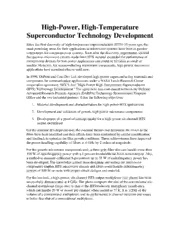
NASA Technical Reports Server (NTRS) 20050180241: High-Power, High-Temperature Superconductor Technology Development PDF
Preview NASA Technical Reports Server (NTRS) 20050180241: High-Power, High-Temperature Superconductor Technology Development
High-Power, High-Temperature Superconductor Technology Development Since the first discovery of high-temperature superconductors (HTS) 10 years ago, the most promising areas for their applications in microwave systems have been as passive components for communication systems. Soon after the discovery, experiments showed that passive microwave circuits made from HTS material exceeded the performance of conventional devices for low-power applications and could be 10 times as small or smaller. However, for superconducting microwave components, high-power microwave applications have remained elusive until now. In 1996, DuPont and Com Dev Ltd. developed high-power superconducting materials and components for communication applications under a NASA Lewis Research Center cooperative agreement, NCC3-344 "High Power High Temperature Superconductor (HTS) Technology Development." The agreement was cost shared between the Defense Advanced Research Projects Agency's (DARPA) Technology Reinvestment Program Office and the two industrial partners. It has the following objectives: 1. Material development and characterization for high-power HTS applications 2. Development and validation of generic high-power microwave components 3. Development of a proof-of-concept model for a high-power six-channel HTS output multiplexer For the material development task, the essential factors that determine the losses in the films have been identified and their effects have been minimized by careful consideration and feedback to optimize the film growth conditions. These achievements have improved the power-handling capability of filters at 4 GHz by 2 orders of magnitude. For the generic microwave components task, a three-pole filter that can handle more than 100 W of radiofrequency power with a 1-percent bandwidth has been demonstrated. Also, a method to measure calibrated S-parameters up to 35 W of radiofrequency power has been developed. The knowledge gained from designing and testing the microwave components implies HTS microwave circuits and filters could handle radiofrequency powers of 500 W or more with proper circuit designs and material. For the last task, a high-power, six-channel HTS output multiplexer (see photo) has been successfully demonstrated at 4 GHz. The photo compares the size of the conventional six- channel multiplexer (large one) to that of the HTS/dielectric multiplexer (small one), which can handle 20 W of power per channel when cooled to 77 K. It is 1/20th of the volume of a conventional multiplexer, and its performance in channel isolation and losses is better than that of a conventional multiplexer. Comparison of a conventional C-band output multiplexer with the HTS/dielectric multiplexer developed by ComDev and DuPont under a cooperative agreement with NASA Lewis and the Defense Advanced Research Projects Agency (DARPA). Both multiplexers can handle 24 W of microwave power per channel. As part of the agreement, a thermal analysis of the system was done. The study determined, using the available technology data for HTS filter losses and cryocooler losses obtained during the first quarter of the 2-year agreement, that there was a 5- to 7-W dc- power penalty per channel for a high-power C-band multiplexer. However, with a factor of 2 improvement in the HTS filter losses, the dc-power losses were essentially zero. The needed improvement to achieve a zero dc-power penalty is readily achievable by using the techniques of improved film quality and circuit design that were demonstrated in the latter part of the agreement. Recent improvements in cryocooler design have resulted in a threefold to fourfold increase in cooling power. This increase, coupled with the anticipated reduction of radiofrequency losses for a multiplexer, will result in a net gain of 3 to 6 W of dc-power per channel. For a typical 24-band C-band satellite, 72 to 144 W can be saved. As a follow-on, high-power and low-power hybrid superconductive and semiconductive microwave circuits will be integrated with cryocoolers that use realistic communication payloads. Lewis contacts: Dr. Kul B. Bhasin, (216) 433-3676, [email protected]; and Joseph D. Warner, (216) 433-3677, [email protected] Author: Dr. Kul B. Bhasin Headquarters program office: OSAT
